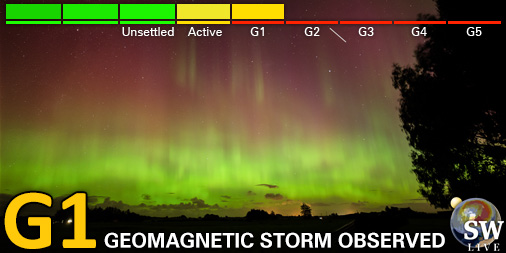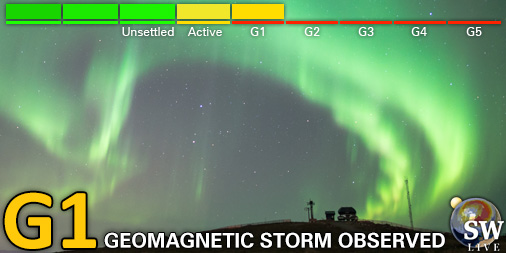Het archief bekijken van vrijdag 16 augustus 2024
Dagelijks bulletin over zonne- en geomagnetische activiteit van het SIDC
Datum verslag: 2024 Aug 16 1231 UTC
SIDC Prognose
Zonnevlammen
M-class flares expected (probability >=50%)
Geomagnetisme
Quiet (A<20 and K<4)
Proton Flux monitor
Quiet
| 10cm flux | Ap | |
|---|---|---|
| 16 Aug 2024 | 217 | 010 |
| 17 Aug 2024 | 213 | 011 |
| 18 Aug 2024 | 209 | 015 |
Zonnevlekkengebieden en zonnevlammen
Solar flaring activity over the past 24 hours was at low levels. The largest flare was a C7.8-flare, with peak time 17:35 UTC on August 15 and is associated with NOAA AR 3786 (beta). There are currently 9 numbered active regions on the visible disk. NOAA AR 3780 (beta-gamma-delta) and NOAA AR 3784 (beta-gamma-delta) are the largest and most magnetically complex regions on disk. NOAA AR 3780 and NOAA AR 3781 have started to rotate over the west limb. NOAA AR 3789 has turned into a plage region. The solar flaring activity is likely to be at moderate levels over the coming days with C-class flares expected, M-class flares very likely and a small chance for an X-class flare.
Coronale massa uitstoten
No Earth-directed Coronal Mass Ejections (CMEs) have been detected in the available coronagraph images.
Coronale gaten
A positive high-latitude polarity coronal hole is transitioning the central meridian in the southern hemisphere. For this coronal hole, no impact at Earth is expected from its associated high-speed stream.
Zonnewind
The solar wind conditions reflected a slow solar wind regime. The solar wind speed varied between 319 km/s to 382 km/s. The interplanetary magnetic field varied between 2 nT and 9 nT, with the Bz reaching a minimum value of -6 nT. The phi-angle was mainly in the negative sector (directed towards the Sun) with periods in the positive. Slow solar wind conditions are expected to continue over the next 24 hours. The solar wind is expected to become perturbed late on August 17 or on August 18 due to the expected arrival of an ICME.
Geomagnetisme
Geomagnetic conditions were globally and locally quiet to unsettled (NOAA Kp 1 - 3 and K BEL 1 - 3). Geomagnetic conditions are expected to be at quiet to unsettled levels in the next 24 hours.
Proton flux niveaus
Over the past 24 hours the greater than 10 MeV GOES proton flux was at background levels and is expected to remain so over the next days.
Elektronenfluxen in geostationaire baan
The greater than 2 MeV electron flux measured by GOES 16 was below the 1000 pfu threshold and is expected to remain so in the upcoming days. The 24h electron fluence was at nominal level and is expected to remain so in the next days.
Het geschatte internationale zonnevlekkengetal (ISN) van vandaag: 201, gebaseerd op 10 stations.Zon indexen voor 15 Aug 2024
| Wolfgetal Catania | /// |
| 10cm zonneflux | 227 |
| AK Chambon La Forêt | /// |
| AK Wingst | 006 |
| Geschatte Ap | 008 |
| Geschat internationaal zonnevlekkengetal | 164 - Gebaseerd op 23 stations |
Overzicht opvallende gebeurtenissen
| Dag | Start | Max | Einde | Locatie | Sterkte | OP | 10cm | Catania/NOAA | Soorten radio-uitbarstingen | |
|---|---|---|---|---|---|---|---|---|---|---|
| Geen | ||||||||||
Aangeboden door het Solar Influences Data Analysis Center© - SIDC - Verwerkt door SpaceWeatherLive
Alle tijden in UTC
<< Keer terug naar de dagelijkse overview pagina
Op basis van de huidige parameters is er in de nabije toekomst een beperkte kans op poollicht op de volgende locaties van de hoge breedtegraad
Gillam, MB, Yellowknife, NTLaatste nieuws
Laatste forumberichten
Steun Poollicht.be!
Om ook bereikbaar te blijven bij grote poollichtkansen hebben we een zware server nodig die alle bezoekers aankan. Doneer en steun dit project zodat we online blijven en je geen enkele poollichtkans mist!

Laatste alerts
zondag 6 april 2025
02:00 UTC - Geomagnetische activiteit
G1 - Kleine geomagnetische storm (Kp5) Drempel bereikt: 01:50 UTC
zaterdag 5 april 2025
20:30 UTC - Geomagnetische activiteit
G1 - Kleine geomagnetische storm (Kp5) Drempel bereikt: 20:20 UTC
20:24 UTC - Zonnevlam
Matige M1.05 zonnevlam
20:09 UTC - Radio blackout
Kleine R1 radio blackout gedetecteerd (≥M1 - momenteel: M1.05)
10:00 UTC - Hemisferisch vermogen
Het OVATION-model voorspelt dat het hemisferisch vermogen 78GW zal bereiken om 10:32 UTC
Ruimteweer feitjes
| Laatste X-klasse uitbarsting | 28/03/2025 | X1.1 |
| Laatste M-klasse uitbarsting | 05/04/2025 | M1.0 |
| Laatste geomagnetische storm | 06/04/2025 | Kp5 (G1) |
| Zonnevlekkenloze dagen | |
|---|---|
| Laatste zonnevlekkenloze dag | 08/06/2022 |
| Maandelijks gemiddeld zonnevlekkengetal | |
|---|---|
| maart 2025 | 134.2 -20.4 |
| april 2025 | 150.4 +16.2 |
| Afgelopen 30 dagen | 132.4 -10.1 |





